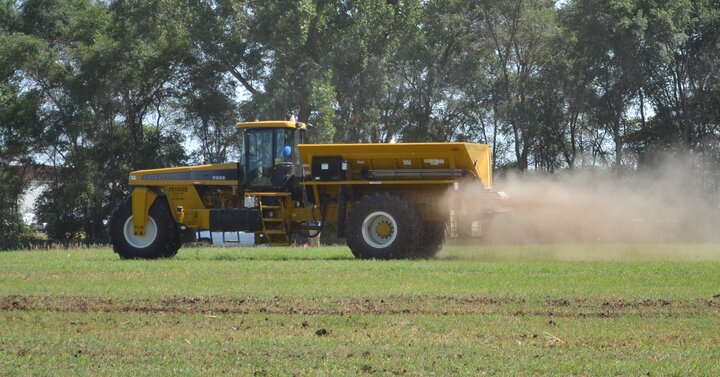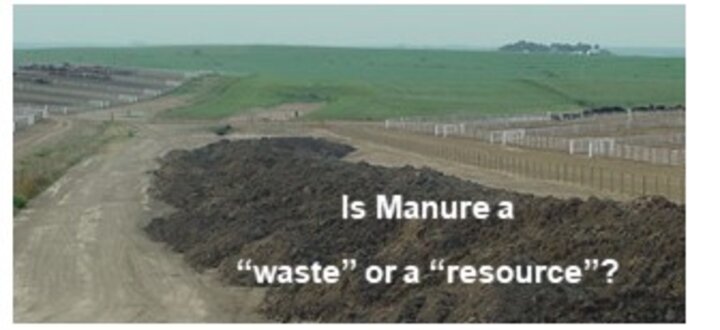Manure Reduces Nitrate Losses to Water in Iowa Study

Iowa State University researchers concluded from a long-term field study that poultry manure, when applied at a rate to meet the crop nitrogen (N) requirements, can reduce nitrate loss and achieve equal or better yields in corn soybean production systems. This research effort, Long-term Effects of Poultry Manure Application on Nitrate Leaching in Tile Drain Waters, evaluated tile drain field plots over 12 cropping seasons. While this research focused on nitrate (NO3-N) loss by field-tile drains (typically placed 3 to 6 feet deep), similar trends would be anticipated in Nebraska for nitrate leaching below the crop root zone and the eventual impacts on ground and, possibly, surface water quality.
The research team evaluated four N treatments including poultry manure application rates of 150 lbs. N/acre (PM150) and 300 lbs. N/acre (PM300), urea ammonium nitrate (UAN) at 150 lbs. N/acre (UAN150), and a control at 0 lbs. N/acre (Control) on a tile-drained field near Ames, IA from 1998 to 2009. Manure and UAN were typically applied on the same day, typically between mid-April and mid-May. The research was conducted in loam soils with organic matter averaging 3.4% in the top 12 inches. Nitrate-N loss was measured from mid-March to October.
Animal Manures Reduce Nitrogen Loss


Average cumulative nitrate-N loss for the UAN150 treatment was significantly greater than nitrate-N experienced by the PM150 treatment (see Figure 1). In addition, over application of animal manure (PM300) increased nitrate-N movement to tile drains than an agronomic rate of commercial fertilizer (UAN150) or manure (PM150). Nitrate losses were highest during March through June (periods of low evapotranspiration rates and high precipitation) and lowest during July through September (low precipitation, higher evapotranspiration, and deeper root zone).
Take Home Message:Poultry manure applied at agronomic rates reduces loss of nitrate from the crops root zone as compared to commercial fertilizer and over application of manure.
Why? Several factors contribute to the reduced nitrate losses from manure substituted for commercial fertilizer. A review of 141 studies by Xia (et al., 2017) where manure was substituted for fertilizer identified three likely explanations:
- Slow release of N stored in manure’s organic matter results in N release later in the growing season;
- Rapid soil microbial growth resulting from manure’s carbon (energy for microbes) immobilizes nitrate-N early in the growing season. This microbial N is released later in the crop growing season; and
- Improvements in soil properties including water stable soil aggregates and cation exchange capacity holds of soil mineral N in place.
Similar results for reduced leaching of N from manured fields was observed by Xia (et al., 2017) review of 141 manure versus commercial fertilizer comparisons (see Does Manure Benefit Crop Productivity? Environment?).
Take Home Message:Poultry manure demonstrates equal or greater yields than commercial fertilizer when applied at similar N rates.
Yield and Nitrogen Source?
Manure and fertilizer treatments were applied prior to corn planting in plots maintained in a corn-soybean rotation. On average, corn yield responded to N as follows:
PM300 > PM150 = UAN150 > Control
Soybean yield responded to N as follows:
PM300 > PM150 > UAN150 > Control
Actual yields are summarized in Table 1. The authors state that “The findings from this long-term study show promising results for the use of poultry manure to reduce NO3-N leaching to tile waters and improve yields when compared to traditional UAN application.”
| Crop | PM300 | PM150 | UAN150 | Control |
|---|---|---|---|---|
| Corn (2) | 177a | 161b | 155b | 92 |
| Soybeans (2) | 52a | 49b | 42c | 36 |
| 1 Corn and soybean yields corrected to 15.5% and 13% moisture 2 Values followed by the same letter are not significantly different. |
||||
When Does Nitrate-N Leach?
The 12-year evaluation period produced results commonly expected for movement of water to tile drains. Distribution of rainfall during the growing season impacted both water flow and nitrate concentrations. For example, higher than normal precipitation during April and May resulted in higher than normal tile flow volumes, nitrate concentrations in tile flow, and nitrate losses. Wet and dry cycles of weather conditions also influenced annual tile drain water volume and nitrate losses. Limiting the nitrate-N pool in the soil during the spring (when water movement beyond the root zone is common) is important to protecting water quality. Animal manure can achieve this outcome.
The authors also noted that land application of poultry manure according to recommended N rates is an environmentally preferable source of N compared to UAN (and likely other common commercial fertilizers). However, the author’s noted that at the currently accepted N application rate for both UAN and PM, “NO3-N concentrations measured in tile drainage outflow exceeded the EPA requirements for safe drinking water.”
Does This Apply to Nebraska?
The general trends observed by this Iowa study would be expected for leaching losses of nitrate-N from Nebraska corn and soybean fields. Risk of nitrate-N losses is highest prior to planting and during early growing season. Low evapotranspiration rates, higher precipitation, and the presence of nitrate-N is a recipe for N loss in drain tiles in Iowa and leaching to groundwater in Nebraska.
Take Home Message:Most animal manures will demonstrate similar results and, if applied at agronomic rates, reduce the risk of nitrates in Nebraska’s ground water.
Similar results are also anticipated for most animal manures. Most slurry and solid manure’s store much of their N in a slow release organic form and supply sufficient carbon for rapid soil microbial growth following manure application. These properties are important to a fertility product with less risk of N leaching.
Additional Reading:
This article was reviewed by Brian Krienke, Katie Pekarek and Aaron Mittelstet, University of Nebraska-Lincoln